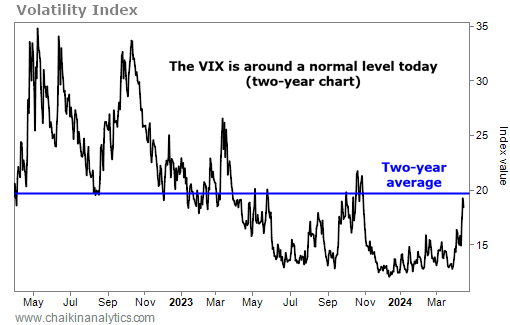
Volatility Is Back… And That’s a Good Thing
Stocks just went on an incredible five-month run…
The S&P 500 Index surged roughly 25% from the end of October through the end of March. That’s the best five-month performance for the benchmark index since 2020.
Perhaps more impressively, the S&P 500 didn’t suffer a single 2% pullback in that span.
A few catalysts led to this strong, steady rally…
First, the U.S. economy is in great shape.
The latest data from the government showed a 3%-plus annual growth rate in gross domestic product. Meanwhile, unemployment remains historically low. And wages are up roughly 4% over the past 12 months.
American consumers keep spending, too. This week’s retail-sales data (for the month of March) came in well above expectations.
Finally, earnings for S&P 500 companies are still moving higher. Goldman Sachs analysts expect earnings growth of about 8% this year.
Until recently, we could’ve added “expected Federal Reserve interest-rate cuts” to that list. However, all this strong economic data has crushed investors’ hopes for a rate cut in June.
That’s fine by me, though. A strong economy is never bad for investors.
But you’ve probably noticed a side effect of these dampened rate-cut expectations…
In short, volatility is back.
Stocks have been a lot more turbulent over the first two and a half weeks of April. On Wednesday, the S&P 500 closed about 4.4% below its all-time high (set on March 28).
That’s the biggest pullback since October.
The Chicago Board Options Exchange’s Volatility Index (“VIX”) is known as the market’s “fear gauge.” It’s simply a measure of investors’ expectations for volatility going forward.
If it’s rising, it means investors are getting more worried. And if it’s falling, it means investors don’t have many fears.
Today, the VIX helps us see the rising turbulence in the market. It just broke out to a five-month high. Take a look…
As you can see, the VIX has surged over the past few weeks. But you’ll also notice that it’s trading right around its two-year average of just below 20.
In other words… volatility is finally back to a normal level.
Following such a long stretch of calmness in the market, a period of volatility makes sense. After all, we all know that stocks don’t go up in a straight line forever.
Today, the market is more cautious than it has been in months.
But my point is simple…
That’s a good thing. It’s a sign of a healthy market.
In the short term, we can expect more volatility. The market could experience further declines over the next few weeks as nervous investors sell some of their positions.
And as I’ve said repeatedly, I’m hoping to see a pullback soon.
Remember, as I wrote in the Chaikin PowerFeed a little more than a month ago…
The final seven months of presidential-election years (from June 1 to December 31) are often the best-returning months. In 16 of the past 18 presidential-election years, the S&P 500 was up over that span. And in all those instances, the index averaged a 10% gain.
That period is fast approaching. But we’re not there yet. So a continued pullback in the coming days wouldn’t necessarily be a bad thing…
A sell-off could create excellent entry points ahead of the next big rally to end the year.
Good investing,
Marc Chaikin
Recent Articles
‘Complicated’ Technologies Are the Innovations You Want to Get Behind
Editor’s note: Chaikin Analytics founder Marc Chaikin isn’t a cryptocurrency expert. But he has spent decades developing leading-edge technologies for major financial institutions. That’s why he wants to share an important message from our friend Eric Wade today… Regular Chaikin PowerFeed readers will remember that Eric is a crypto expert over at our corporate affiliate
Here’s How Our System Saw Energy’s Breakout Coming
Once again, the calculus has changed in the Middle East conflict… Over the weekend, Iran directly attacked Israel. It launched more than 300 missiles and drones. Israel and its partners claim to have shot most of them down. And now, all sides are considering their “next steps.” It’s a tense moment. And it’s one that
What the Latest Inflation Numbers Mean for Investors
Last week’s inflation data surprised a lot of folks… On Wednesday, the U.S. Bureau of Labor Statistics released its Consumer Price Index (“CPI”) report for March. In short, the numbers came in above expectations. So-called “headline” inflation was up 3.5% year over year. And “core” inflation (which ignores food and energy costs) showed that prices
Get Stock Ideas & More, Delivered Daily with Chaikin PowerFeed


Anticipate upcoming market movements, get stock ideas daily, earnings updates, trends, and more! Delivered to your inbox Monday through Friday — 100% FREE.
Receive daily market updates, sector tracking, in-depth industry analysis, earnings updates, and actionable ideas via our Chaikin PowerFeed newsletter.
